
The Mongols are an East Asian ethnic group native to Mongolia, Inner Mongolia in China, and the Buryatia Republic of the Russian Federation. The Mongols are the principal member of the large family of Mongolic peoples. The Oirats in Western Mongolia as well as the Buryats and Kalmyks of Russia are classified either as distinct ethno-linguistic groups or subgroups of Mongols.

Mongolia is a landlocked country in East Asia, bordered by Russia to the north and China to the south. The western extremity of Mongolia is only 23 km (14 mi) from Kazakhstan, and this area can resemble a quadripoint when viewed on a map. It covers an area of 1,564,116 square kilometres, with a population of just 3.3 million, making it the world's most sparsely populated sovereign state. Mongolia is the world's largest landlocked country that does not border a closed sea, and much of its area is covered by grassy steppe, with mountains to the north and west and the Gobi Desert to the south. Ulaanbaatar, the capital and largest city, is home to roughly half of the country's population.
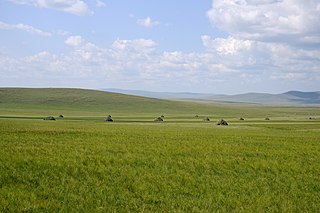
Inner Mongolia, officially the Inner Mongolia Autonomous Region, is an autonomous region of the People's Republic of China. Its border includes two-thirds of the length of China's border with the country of Mongolia. Inner Mongolia also accounts for a small section of China's border with Russia. Its capital is Hohhot; other major cities include Baotou, Chifeng, Tongliao, and Ordos.
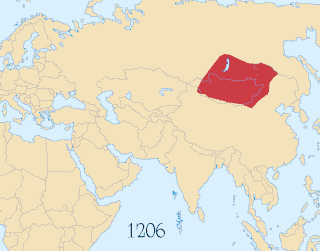
The Mongol Empire of the 13th and 14th centuries was the largest contiguous empire in history. Originating in present-day Mongolia in East Asia, the Mongol Empire at its height stretched from the Sea of Japan to parts of Eastern Europe, extending northward into parts of the Arctic; eastward and southward into parts of the Indian subcontinent, attempted invasions of Southeast Asia, and conquered the Iranian Plateau; and westward as far as the Levant and the Carpathian Mountains.
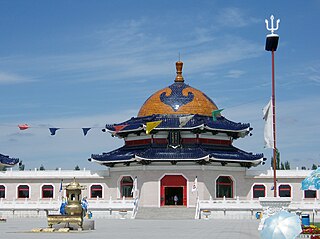
The Mausoleum of Genghis Khan is a mausoleum dedicated to Genghis Khan, where he is worshipped as ancestor, dynastic founder, and deity. The mausoleum is better called the Lord's Enclosure, the traditional name among the Mongols, as it has never truly contained the Khan's body. It is the main centre of the worship of Genghis Khan, a growing practice in the Mongolian shamanism of both Inner Mongolia, where the mausoleum is located, and Mongolia.

Hulagu Khan, also known as Hülegü or Hulegu, was a Mongol ruler who conquered much of Western Asia. Son of Tolui and the Keraite princess Sorghaghtani Beki, he was a grandson of Genghis Khan and brother of Ariq Böke, Möngke Khan, and Kublai Khan.

The culture of Mongolia has been shaped by the country's nomadic tradition and its position at the crossroads of various empires and civilizations. Mongolian culture is influenced by the cultures of the Mongolic, Turkic, and East Asian peoples, as well as by the country's geography and its history of political and economic interactions with other nations.

The Pax Mongolica, less often known as Pax Tatarica, is a historiographical term modeled after the original phrase Pax Romana which describes the stabilizing effects of the conquests of the Mongol Empire on the social, cultural and economic life of the inhabitants of the vast Eurasian territory that the Mongols conquered in the 13th and 14th centuries. The term is used to describe the eased communication and commerce the unified administration helped to create and the period of relative peace that followed the Mongols' vast conquests.
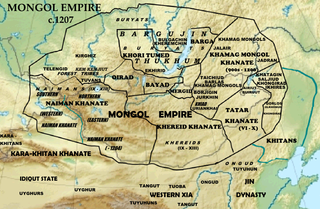
A Borjigin is a member of the Mongol sub-clan that started with Bodonchar Munkhag of the Kiyat clan. Yesugei's descendants were thus said to be Kiyat-Borjigin. The senior Borjigids provided ruling princes for Mongolia and Inner Mongolia until the 20th century. The clan formed the ruling class among the Mongols and some other peoples of Central Asia and Eastern Europe. Today, the Borjigid are found in most of Mongolia, Inner Mongolia and Xinjiang, and genetic research has shown that descent from Genghis Khan and Timur is common throughout Central Asia and other regions.
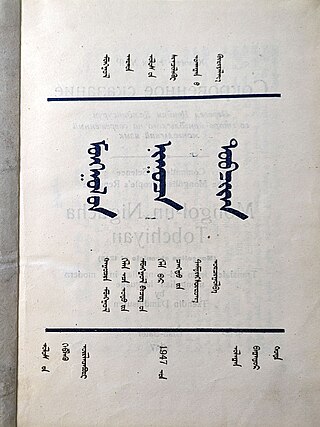
The Secret History of the Mongols is the oldest surviving literary work in a Mongolian language. Written for the Mongol royal family some time after the death of Genghis Khan in 1227, it recounts his life and conquests, and partially, the reign of his successor Ögedei Khan.
Jamukha was a Mongol military and political leader and the chief rival to Temüjin in the unification of the Mongol tribes.
Genghis Khan, also known as Chinggis Khan, was the founder and ruler of the Mongol Empire.

The location of the burial place of Genghis Khan has been the subject of much speculation and research. The site remains undiscovered, although it is generally believed that it is near the Mongol sacred mountain of Burkhan Khaldun in the Khentii Mountains.
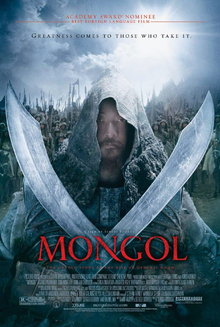
Mongol (Монгол), also known as Mongol: The Rise of Genghis Khan in the United States and Mongol: The Rise to Power of Genghis Khan in the United Kingdom, is a 2007 period epic film directed by Sergei Bodrov, about the early life of Temüjin, who later came to be known as Genghis Khan. The storyline was conceived from a screenplay written by Bodrov and Arif Aliev. It was produced by Bodrov, Sergei Selyanov, and Anton Melnik and stars Tadanobu Asano, Sun Honglei, and Chuluuny Khulan in the main roles. Mongol explores abduction, kinship, and the repercussions of war.

Genghis Khan, also known as Chinggis Khan, was the founder and first khan of the Mongol Empire, which he ruled from 1206 until his death in 1227; it later became the largest contiguous empire in history. Having spent most of his life uniting the Mongol tribes, he launched a series of military campaigns, conquering large parts of China and Central Asia.
Various nomadic empires, including the Xiongnu, the Xianbei state, the Rouran Khaganate (330–555), the First (552–603) and Second Turkic Khaganates (682–744) and others, ruled the area of present-day Mongolia. The Khitan people, who used a para-Mongolic language, founded an empire known as the Liao dynasty (916–1125), and ruled Mongolia and portions of North China, northern Korea, and the present-day Russian Far East.
John Anthony Garnet Man is a British historian and travel writer. His special interests are China, Mongolia and the history of written communication.

Genghis Khan is a Chinese television series based on the life of Genghis Khan, the founder of the Mongol Empire in the 13th century. Ba Sen, who portrayed the eponymous character in the series, is a descendant of Genghis Khan's second son, Chagatai. The series was first broadcast on CCTV in China in 2004, on KBS in South Korea in 2005, and the Turkish state channel TRT 1.

The Mongols were highly tolerant of most religions during the early Mongol Empire, and typically sponsored several at the same time. At the time of Genghis Khan in the 13th century, virtually every religion had found converts, from Buddhism to Eastern Christianity and Manichaeanism to Islam. To avoid strife, Genghis Khan set up an institution that ensured complete religious freedom, though he himself was a Tengrist. Under his administration, all religious leaders were exempt from taxation, and from public service. Mongol emperors were known for organizing competitions of religious debates among clerics, and these would draw large audiences.

Marco Polo is an American drama streaming television series inspired by Marco Polo's early years in the court of Kublai Khan, the Khagan of the Mongol Empire and the founder of the Yuan dynasty (1271–1368). The show premiered on Netflix on December 12, 2014. The series was created by John Fusco and stars Lorenzo Richelmy in the title role, with Benedict Wong as Kublai Khan. It was produced by The Weinstein Company. On January 7, 2015, Marco Polo was renewed by Netflix for a 10-episode second season, which premiered on July 1, 2016.

















